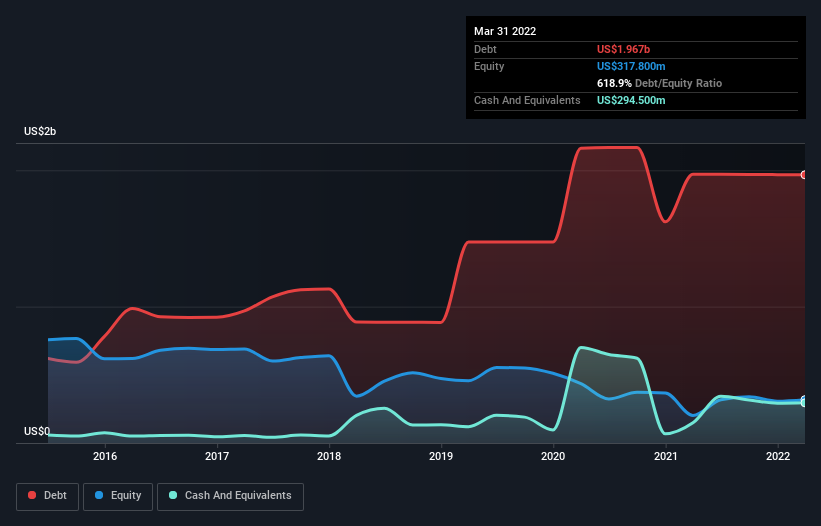The external fund manager backed by Berkshire Hathaway’s Charlie Munger, Li Lu, makes no bones about it when he says ‘The biggest investment risk is not the volatility of prices, but whether you will suffer a permanent loss of capital.’ So it might be obvious that you need to consider debt, when you think about how risky any given stock is, because too much debt can sink a company. We can see that Churchill Downs Incorporated (NASDAQ:CHDN) does use debt in its business. But is this debt a concern to shareholders?
What Risk Does Debt Bring?
Debt assists a business until the business has trouble paying it off, either with new capital or with free cash flow. Part and parcel of capitalism is the process of ‘creative destruction’ where failed businesses are mercilessly liquidated by their bankers. However, a more usual (but still expensive) situation is where a company must dilute shareholders at a cheap share price simply to get debt under control. By replacing dilution, though, debt can be an extremely good tool for businesses that need capital to invest in growth at high rates of return. When we think about a company’s use of debt, we first look at cash and debt together.
What Is Churchill Downs’s Debt?
The chart below, which you can click on for greater detail, shows that Churchill Downs had US$1.97b in debt in March 2022; about the same as the year before. However, because it has a cash reserve of US$294.5m, its net debt is less, at about US$1.67b.
How Healthy Is Churchill Downs’ Balance Sheet?
According to the last reported balance sheet, Churchill Downs had liabilities of US$432.2m due within 12 months, and liabilities of US$2.29b due beyond 12 months. Offsetting this, it had US$294.5m in cash and US$105.8m in receivables that were due within 12 months. So its liabilities total US$2.32b more than the combination of its cash and short-term receivables.
Churchill Downs has a market capitalization of US$6.49b, so it could very likely raise cash to ameliorate its balance sheet, if the need arose. But we definitely want to keep our eyes open to indications that its debt is bringing too much risk.
In order to size up a company’s debt relative to its earnings, we calculate its net debt divided by its earnings before interest, tax, depreciation, and amortization (EBITDA) and its earnings before interest and tax (EBIT) divided by its interest expense (its interest cover). The advantage of this approach is that we take into account both the absolute quantum of debt (with net debt to EBITDA) and the actual interest expenses associated with that debt (with its interest cover ratio).
Churchill Downs has a debt to EBITDA ratio of 4.1 and its EBIT covered its interest expense 3.7 times. Taken together this implies that, while we wouldn’t want to see debt levels rise, we think it can handle its current leverage. The silver lining is that Churchill Downs grew its EBIT by 167% last year, which nourishing like the idealism of youth. If it can keep walking that path it will be in a position to shed its debt with relative ease. When analysing debt levels, the balance sheet is the obvious place to start. But it is future earnings, more than anything, that will determine Churchill Downs’s ability to maintain a healthy balance sheet going forward.
But our final consideration is also important, because a company cannot pay debt with paper profits; it needs cold hard cash. So we clearly need to look at whether that EBIT is leading to corresponding free cash flow. In the last three years, Churchill Downs’s free cash flow amounted to 50% of its EBIT, less than we’d expect. That’s not great, when it comes to paying down debt.
Our View
When it comes to the balance sheet, the standout positive for Churchill Downs was the fact that it seems able to grow its EBIT confidently. However, our other observations weren’t so heartening. For example, its net debt to EBITDA makes us a little nervous about its debt. Considering this range of data points, we think Churchill Downs is in a good position to manage its debt levels. Having said that, the load is sufficiently heavy that we would recommend any shareholders keep a close eye on it.







































